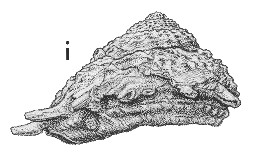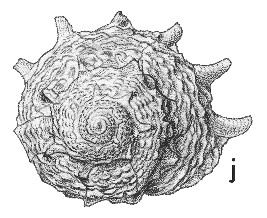
Revised descriptions of New Zealand Cenozoic Mollusca from Beu and Maxwell (1990)

 | Revised descriptions of New Zealand Cenozoic Mollusca from Beu and Maxwell (1990) | 
|
  (Pl. 14i): GS9805, F44/f9501, Coal Brook Station, Wendon Valley, Southland, Duntroonian (GNS) |
  (Pl. 14j): GS9805, F44/f9501, Coal Brook Station, Wendon Valley, Southland, Duntroonian (GNS) |
Beu & Maxwell (1990): Chapter 10; p. 155; pl. 14 i, j.
Synonymy: A. (Cyclocantha) bicarinata Suter 1917, p. 6
Classification: Turbinidae
Description: Large for genus (height 56 mm; diameter (including spines) greater than 90 mm, (excluding spines) 77 mm), trochiform, spire moderately low. Spire whorls strongly convex and clasping, spreading up to peripheral keel of previous whorl; last whorl with a prominent peripheral angulation at about 0.3 whorl height, bearing long, slightly forward-directed, anteriorly hollow spines, and another prominent peribasal angulation well below periphery; base concave; umbilicus narrowly open in small specimens but hidden by inner lip callus in adults. On spire whorls spines rest on surface of succeeding whorl. Sculpture on dorsal surface of prominent, slightly irregular, coarsely nodulose spiral cords that turn outward to become slightly radial near periphery, and of many very fine, very faintly gemmate lirae over the surface of, and parallel to, the more prominent cords. Basal sculpture of 2 very prominent nodulose cords, one at peribasal angulation and one halfway between it and periphery, 3 other major nodulose cords and many very fine ones, and low radial lamellae (margins of former inner lip callus pads) extending out from umbilicus. Operculum large, thin, flat, oval, almost smooth, with a weak marginal ridge.
Comparison: The style of sculpture, the long peripheral spines, the basal and particularly the umbilical sculpture, and the presence of an open umbilicus (if only in immature specimens) in Astraea bicarinata are very similar to corresponding characters in A. heliotropium, the type species of Astraea Roding, 1798, and there is little doubt that A. bicarinata is a typical Astraea, possibly an early member of a lineage ancestral to A. heliotropium. The large shell figured here differs from the few available specimens from the type locality only in its weaker basal cords and its more prominent cord between the peripheral and peribasal angulations; we judge them to be conspecific.
Astraea heliotropium (= A. anthropophagus (Marwick, 1928)) (Tongaporutuan-Recent) is a reasonably common fossil in New Zealand, and modern specimens are dredged commonly on the inner-mid shelf all around the country. Its main distinguishing characters are its widely open umbilicus and its large size compared with overseas species usually referred to Astraea. A. stirps (Altonian-Lillburnian, Clifden) is only slightly different from A. heliotropium, differing in having a taller spire and a slightly narrower umbilicus, and apparently intergrades. An unnamed, low-spired species with a deeply concave base and a wide umbilicus recorded from the Otekaike Limestone, Waitaki Valley (Waitakian) and Tarakohe Quarry, Takaka (Altonian), and the forms here included in A. bicarinata indicate that several lineages existed in New Zealand during the mid-Cenozoic. Earlier forms with a quite narrow, but still open, umbilicus are known from the Deborah Volcanic Formation at Kakanui (Whaingaroan) and from the Waiareka Volcanic Formation at Lorne, near Oamaru (Kaiatan), and indicate that Astraea evolved from a Bolma-like ancestor in New Zealand, probably during Paleocene or Early Eocene time, and that only New Zealand species discussed here and two Australian Cenozoic species should be included in Astraea (sensu stricto).
Distribution: Duntroonian-Altonian; basal shellbed, Enys Formation, junction of Porter and Thomas Rivers, Castle Hill Basin, Altonian (type); Chatton Formation, Coal Brook Station, Wendon Valley (Duntroonian).
Cite this publication as: "A.G. Beu and J.I. Raine (2009). Revised
descriptions of New Zealand Cenozoic Mollusca from Beu and Maxwell (1990). GNS
Science miscellaneous series no. 27."
© GNS Science, 2009
ISBN
978-0-478-19705-1
ISSN 1177-2441
(Included with a PDF facsimile file
copy of New Zealand Geological Survey Paleontological Bulletin 58 in CD version
from: Publications Officer, GNS Science, P.O. Box 30368 Lower Hutt, New
Zealand)